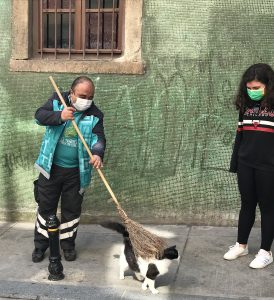“Milk”
 Old names: Skyai, Pera
Old names: Skyai, Pera
These days Galata, the area around the landmark Galata Tower that was once the heart of Genoese Pera, is one of the most touristy parts of İstanbul, full of cafes, restaurants, clothes shops, hotels and others businesses catering to visitors.
All this is relatively new. Twenty-five years ago İstiklal Caddesi, the pedestrianised heart of Beyoğlu, was lively only as far as Galatasaray Meydanı after which the closer it got to the tower the greyer and grungier it became. In those days apartments were snapped up for peanuts by those with a nose for a bargain. Today you’ll search in vain for anything affordable.
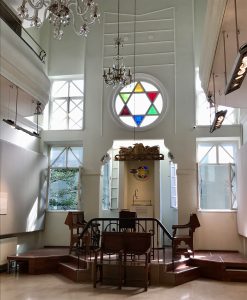
The most obvious attraction here has to be the Galata Tower with the spectacular views from its rooftop balcony. it’s also well worth visiting the Galata Mevlevihanesi Museum on Galipdede Caddesi which is a mine of information on all things dervish. It’s also one of the best and most authentic places to see the whirling dervishes perform. However, in 2024 it was closed for restoration.
Other monuments in the area are low-key and tend to get overshadowed by the shops. Italian and Jewish visitors are likely to find this a particularly rewarding area to explore – in the side streets off Galipdede Caddesi some of the 19th-century apartment blocks have their dates written onto them according to the Jewish calendar.
Backstory
Like Byzantium, Galata was protected by walls from early times, with the first fortifications erected by Constantine and then strengthened by Theodosius.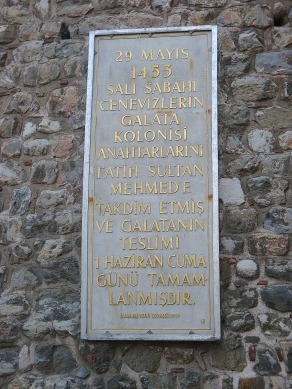 On 29 May 1453 the Genoese surrendered the key of the Tower to the Ottomans
On 29 May 1453 the Genoese surrendered the key of the Tower to the Ottomans
Genoese traders established a foothold in Constantinople as far back as the 11th or 12th century. At first they, like the Venetians, Pisans and Amalfians, managed their affairs from a base on the Golden Horn but after the end of the Latin Interregnum in 1261 they were rewarded for having helped the Byzantine Emperor against the Fourth Crusaders by being allowed to set up a self-governing colony between the Galata Tower and the shores around Karaköy. It was surrounded by walls and governed by a podesta (governor) quite separately from the rest of Constantinople.
In 1453 the Genoese tried to hold on to their privileges by staying neutral between the Byzantines and the Ottomans but it was to no avail. They were forced to hand the keys to their great tower to Fatih Sultan Mehmed and then demolish their walls. The last sections were pulled down in 1864. Now only scant traces remain.
Galata Tower
At 61m tall and capped with a witch’s hat roof, Galata Tower (open daily until 10pm, admission TL650) is the most distinctive feature of the Beyoğlu skyline. It was built by the Genoese – who called it the Tower of Christ – in 1348-49 to replace an earlier tower placed here by the Emperor Justinian in 528, and it formed the apex in a triangle of walls that ran down to the Bosphorus and the Golden Horn. The witch’s hat was only added in the 1960s even though it is now such an indispensable part of its image. A new museum has been created inside the Tower but I have not yet visited it.
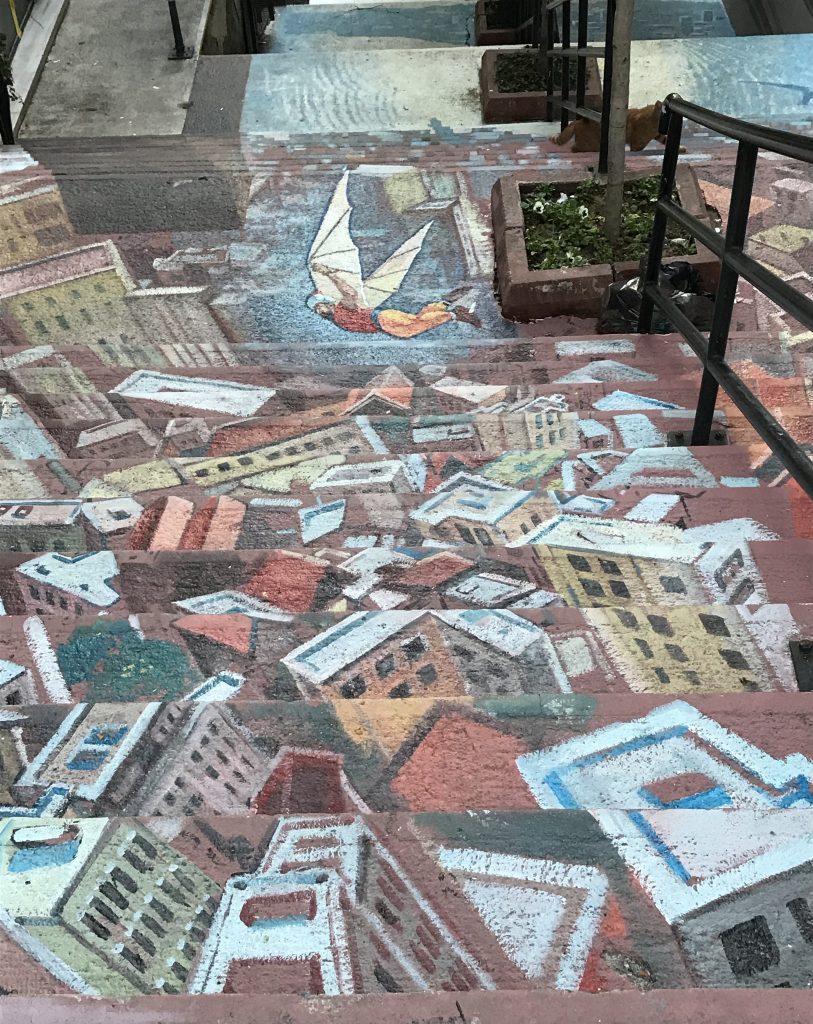
While on the balcony beneath the witch’s hat you should pause to think about Hezarfen Ahmed Çelebi who, in 1638, is thought to have succeeded in flying on makeshift wings from the tower to Doğancılar Meydanı in Üsküdar on the Asian side of the city. That at any rate is the story related by the 17th-century travel writer, Evliya Çelebi, not always the most reliable of sources.
A sign on the wall of the tower commemorates the surrender of the keys of the Genoese colony to Fatih Sultan Mehmed on 29 May 1453.
The Tower stands in a square that these days is always busy but still retains traces of the lost walls that once enclosed the Genoese colony. Against the wall stands the elegant Bereketzade Çeşmesi, brought here in 1732 from a nearby street to replace a much smaller fountain in the 1950s. Beside it a sign commemorates the stay in Galata between 1705 and 1711 of the philosopher Jean-Jacques Rousseau’s father, Isaac Rousseau, who was clockmaker to the palace at the time.
Along Galipdede Caddesi
Assuming that you’ve arrived here on the Tünel funicular or via İstiklal Caddesi you will find Galipdede Caddesi running straight downhill towards the tower. You’ll come almost immediately to the Galata Mevlevihanesi Museum on the left. Galipdede Caddesi itself used to be famous for its antiquarian bookshops and for shops selling musical instruments but these are almost all gone now.
Could you tell a member of the Kadiriyye tarakat from a member of the Celvetiyye? If not, then the Galata Mevlevihanesi Museum (closed Mondays, small admission fee) is the place to come to find out about all the different religious brotherhoods that have played a role in Turkey as well as about the Mevlevi (whirling dervishes) movement and its most famous members.
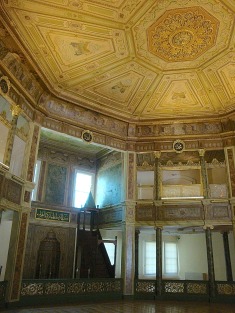 Semahane of the Galata MevlevihanesiThere was always a small museum of literature and musical instruments in the Galata Mevlevihanesi but this has now been moved up into the galleries and an entirely new and surprisingly informative museum has been created beside the semahane (dance hall) where the dervishes still whirl on a regular basis. For exact dates and times check the noticeboard outside.
Semahane of the Galata MevlevihanesiThere was always a small museum of literature and musical instruments in the Galata Mevlevihanesi but this has now been moved up into the galleries and an entirely new and surprisingly informative museum has been created beside the semahane (dance hall) where the dervishes still whirl on a regular basis. For exact dates and times check the noticeboard outside.
As for the Mevelevihane itself, it was originally set up by İskender Paşa, who is buried near the Arasta Bazaar in Sultanahmet, in 1492.
Walking downhill you will pass on the left the restored Teutonia, an imposing apartment block that was once home to the German Club and acted as a Nazi propaganda centre around the time of the Second World War. It how houses the Orient Institute.
Along Serdar-ı Ekrem Sokak
Then you come to a crossroads. If you keep going straight ahead you come eventually to Karaköy. If instead you turn left you can walk along Serdar-ı Ekrem Sokak, until fifteen years ago a completely run-down back street but now the recobbled and cleaned-up street that runs almost as far as the Crimean Memorial Church and that is perhaps Istanbul’s Soho, packed full of designer shops and cafes.
At the far end of Serdar-ı Ekrem stand the Doğan Apartments, a beautiful block of flats set round a garden that was built in 1895 and managed to retain its cachet even during the years when the surrounding area was in decline. Today it’s absolutely prime real estate even though an almost equally fine block across from it still stands empty.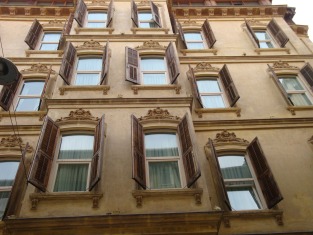 Doğan Apartments
Doğan Apartments
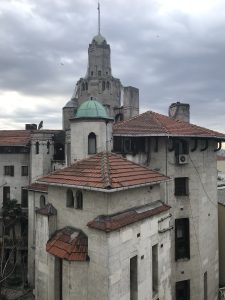
“Little Britain”
If you head downhill along Camekan Sokak behind the tower you will come to a little enclave which was, in the 19th century, the heart of the British community in Constantinople. Here is a second building that makes its presence felt on the skyline – the Beyoğlu Hastanesi which was originally designed by Percy Adams in 1904 as the British Seamen’s Hospital. Its distinctive tower, which will remind some of an egg in an eggcup, served as a watchtower so that mariners could signal ahead if they had emergency patients on board. It stands on what was originally the garden of the British Embassy (the somewhat dejected pink building beside it). In 1924 the British passed the hospital to the Red Crescent.
Nearby is a multi-purpose cafe called Postane which is housed inside what was between 1859 an d1895, the British post office built on the site of an older military post office set up during the Crimean War (1853-56). It later became the English High School for Boys.
If instead you walk down Galata Kulesi Sokak you will pass on the left what was once the Galata House Restaurant, charmingly housed in what was, between 1904 and 1919, the British Prison – or rather a police station with cells for the unruly. These buildings are a powerful reminder of the way in which different “millets (peoples)” were allowed to administer their own ways of life (and justice) in Ottoman times.
Lower Galata
Downhill on the right from the British Prison you will see the gate leading into the Dominican Church of Sts Peter and Paul, built in 1841 by Gaspare Fossati. The Dominicans originally worshipped in what is now the Arap Cami in Karaköy and moved to this location when their church was given to the Moors expelled from Spain in 1492. The current huge building is a replacement for older ones lost, as ever, to fire.
Further downhill on the left stands a particularly dejected relic of the days of Genoese power: the 14th-century Podestat, originally a copy of Genoa’s own San Giorgio Palace, from where the Genoese governor asserted his will. It has been slated for restoration for years but nothing ever seems to happen.
The Podestat stands beside steps leading down to Voyvoda (Bankalar) Caddesi in Karaköy. Before going down the steps it’s worth diverting to the right along Kart Çınar Sokağı, a dingy alley with the 18th-century St Peter’s Han looming up on the right. This was built for a French ambassador whose coat of arms still survives on the walls. More poignant used to be the memorial to Andre Chenier, a Constantinople-born French poet who was guillotined in Paris in 1794, aged only 32, but this has mysteriously vanished. In 2024 the Han was under restoration, presumably pending conversion into a hotel.
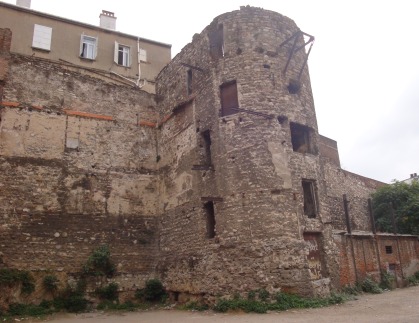 Aside from the Galata Tower little remains of the Genoese fortificationsIf you retrace your steps along Kart Çinar Sokağı you will pass the battered remains of another Genoese building dating back to the 14th cantury and then to the back of the Schneider Synagogue (Tailors’ Synagogue, now an art gallery closed Saturdays) built in Felek Sokak in 1894 for Jewish tailors working in Galata. Beyond that on the right you will see the much-photographed Kamondo Steps running down to Voyvoda (Bankalar) Caddesi. They were placed here in the 1880s to provide a short cut up to Galata from Karaköy.
Aside from the Galata Tower little remains of the Genoese fortificationsIf you retrace your steps along Kart Çinar Sokağı you will pass the battered remains of another Genoese building dating back to the 14th cantury and then to the back of the Schneider Synagogue (Tailors’ Synagogue, now an art gallery closed Saturdays) built in Felek Sokak in 1894 for Jewish tailors working in Galata. Beyond that on the right you will see the much-photographed Kamondo Steps running down to Voyvoda (Bankalar) Caddesi. They were placed here in the 1880s to provide a short cut up to Galata from Karaköy.
Instead of heading down to Karaköy from Galata Tower you could walk along Büyük Hendek Caddesi towards Şişhane. Even the name of this street – Great Moat – commemorates the Genoese fortifications although most people head along it and then turn down in search of the Neve Şalom Synagogue. This started life in a local boys school before moving to a purpose-designed building in 1949. Two bomb attacks, one in 1986, the other in 2003, have left the management very wary of visitors. The Jewish Museum (closed Friday afternoons and Saturdays, admission TL250) has relocated here from near Tünel. 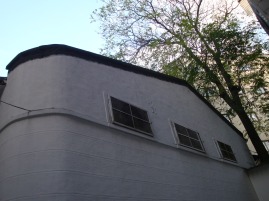 Old matzo bakery
Old matzo bakery
The synagogue aside, there are other reminders of the old Jewish presence in the area including an old matzo bakery that is sometimes used as an exhibition space. Not far away from it, at the back of a car park, you’ll find a crumbling round tower, the last, aside from the Galata Tower itself, to survive from the Genoese fortifications.
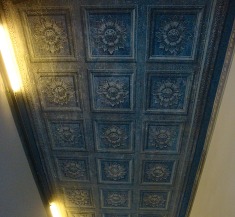 Ceiling of Salti PasajıAlso in the back streets here is the lovely Salti Pasajı, built in 1899 for Sami Salti. Finally, you might want to look out for an Art Nouveau fountain, the Laleli Çeşme, designed by Raimondo d’Aronco in 1904. It’s at the junction of Laleli Çeşme Sokagı and Şair Ziya Paşa Caddesi.
Ceiling of Salti PasajıAlso in the back streets here is the lovely Salti Pasajı, built in 1899 for Sami Salti. Finally, you might want to look out for an Art Nouveau fountain, the Laleli Çeşme, designed by Raimondo d’Aronco in 1904. It’s at the junction of Laleli Çeşme Sokagı and Şair Ziya Paşa Caddesi.
Eating
Mavra Trendy types are always clustered in the doorway of this small and cosy café-bar whose name – meaning “fun and games” – exactly evokes its atmosphere. The menu is broadly international. Serdar-ı Ekrem Sokak No. 31/A, Tel: 0212-252 7488
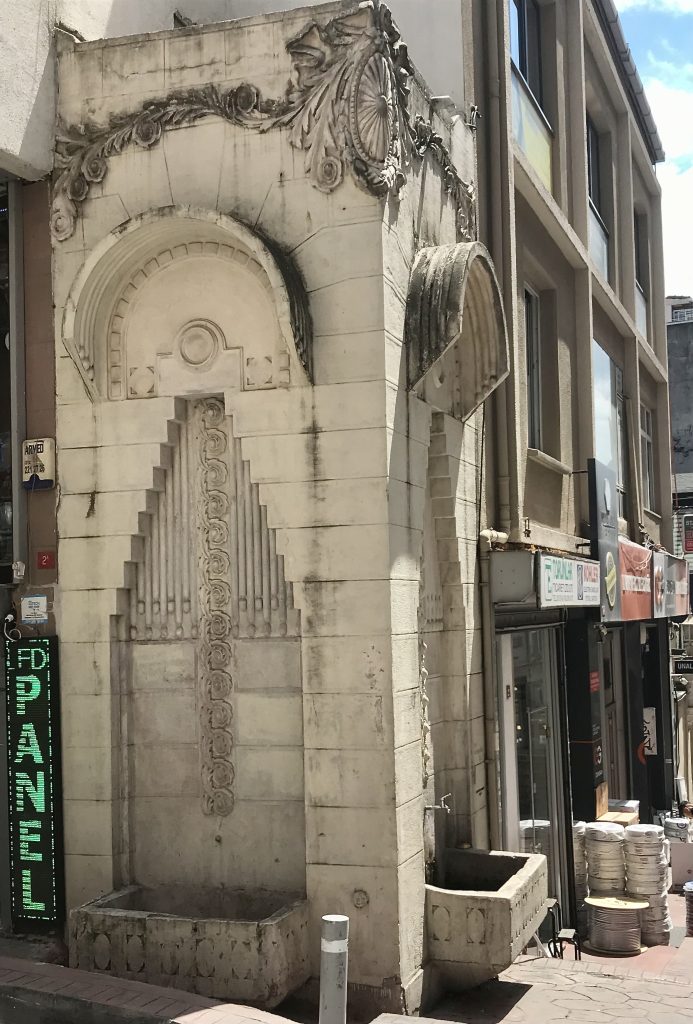
Sleeping
Anemon Galata Hotel A rare hotel on the “modern” side of İstanbul that goes for an antique look in its rooms, the Anemon also has an absolutely winning location with a terrace dining room so close to the Galata Tower that you’d swear you could reach over and touch it. Büyük Hendek Caddesi, Tel: 0212-293 2343
Galata Residence Apart Hotel Housed in a building near the Schneider Synagogue that was built in 1881 by the Kamondo family for destitute members of the Jewish community, the Galata Residence offers comfortably furnished if unflashy apartments in a quiet neighbourhood. You can only book for a week at a time though. Hacı Ali Sokak, Tel: 0212-292 4841
Georges Hotel Housed in the restored Kamondo Han (1861-8) built for the wealthy Kamondo family, this super-stylish 20-room hotel has done away with a reception area which means that you’ll check in in your actual room having walked through the ground-floor Le Fumoir Restaurant to get there. The new rooftop terrace is a big plus. Serdar-ı Ekrem Sokak No. 24, Tel: 0212-244 2423
Transport info
The easiest way to get to Galata is to take the Tünel funicular up from Karaköy and then turn right out of the station and then right again down Galipdede Caddesi which eventually turns into Yüksek Kaldırim and runs right down to Karaköy if you want to walk back.
Alternatively it’s a very pleasant walk – or tram ride – along İstiklal Caddesi.
Nearby areas
Read more about Genoese İstanbul: http://www.turkeyfromtheinside.com/blogbloggingaboutturkey/entry/16-seeking-the-genoese-in-istanbul.html
